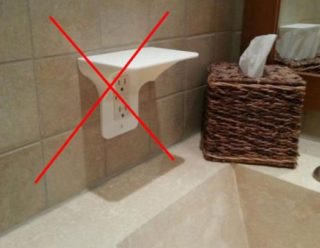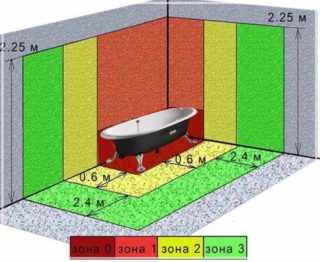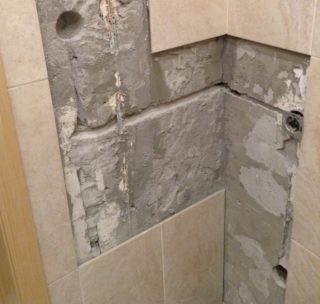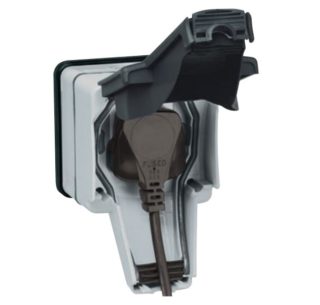When performing repairs in the sanitary room, the master understands that the outlet in the bathroom is often not a whim, but a necessity. You can do it on your own. The main thing is to follow basic safety measures.
The appointment of a food point in the bathroom
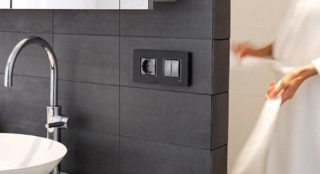
Since in most apartments and houses, residents prefer to switch to autonomous heating, the bathroom is heated using an electric heated towel rail. Under it, you definitely need a socket.
Additionally, in large sanitary rooms they place a washing machine, a boiler, mount wall sconces in the mirror area, and use a hairdryer. All this needs to be connected to the power point. If you place it outside, the comfort of using household appliances will decrease slightly.
Can I install sockets in the bathroom
Until recently (1996), there was a ban on the installation of power points in rooms with high humidity. This was due to the large number of conductive lines in the premises: metal pipes, heated towel rails, washing machines with a metal body.
Now the situation has changed. Water pipes are made of polymers more and more, and household appliances are enclosed in lightweight plastic cases. Therefore, since 2002, the PUE has been regulating the ban on placing outlets only in rooms with a very high humidity level: steam saunas, baths, and also directly in showers.
Installing power points in a private bathroom is not prohibited. But here there are a number of their requirements for compliance with security measures.
Electrical safety requirements
For the safe installation of outlets in the bathroom, the rules of the PUE should be strictly observed:
- Installation of power points is carried out only through RCDs with a current of not more than 30A (protective connection device). As an alternative solution, an isolation transformer can be used. The use of both elements simultaneously enhances the degree of protection of the sanitary room from emergency situations. But this is at the discretion of the master.
- Be sure to ground in the bathroom. Especially if a three-wire cable is mounted. All metal components in the bathroom are grounded, including a shower tray, metal bath, sewer or water supply elements.
- Installation of wiring is done only in a hidden way. The patch method is acceptable provided that all cable connections are carefully insulated.
To mount the outlet above the sink, it is recommended that you install a power point 60 cm away from it and the shower / bath. The optimum height is 1.30 m from the floor and above. Minimum - 90-100 cm.
What type of outlet can I use
In rooms with a high level of humidity, special sockets are required - semi- or fully sealed. More often, masters prefer to use the first option with protection class IP 44 or IP 55. Fully sealed power points are not entirely convenient. The lid is tight, and it is often opened with wet hands, which has a relative risk to the user.
Outlet Area
According to the PUE (paragraph 7.1.47), the bathroom is divided into four zones, each of which has its own recommendations and standards for the placement of food points.
- Zone 0. The space of the shower or bath bowl. The installation of sockets is strictly prohibited.It is permissible to use electrical appliances with a power of 12 volts in this zone. They withstand short-term complete immersion in water and do not pose a danger to humans in the event of such situations.
- Zone 1. Planes in close proximity to the sink, bathtub, shower. Allowed to use electrical appliances, the degree of protection of which is IPX5.
- Zone 2. This is a regulated distance of 60 cm or more from the shower, bathtub, sink. Here you can operate devices with a degree of protection IPX4, which withstand the ingress of drops and splashes of water. In this zone, there is often a cabinet, near which you can place a food point.
- Zone 3. The rest of the bathroom. Installation of sockets is allowed here, but with a protection class IPX4.
The power point for a washing machine or heated towel rail is often made in zone 3. Behind the potentially dangerous perimeters (if the room is large), it is allowed to install sockets with protection class IPX1. But they are also necessarily connected through an RCD.
The choice of wire for the bathroom

In addition to the regulated norms for the location of outlets in the bathroom, it should be borne in mind that all electrical appliances must be connected through wires with a certain cross section. They must withstand the current passing through them.
Recommendations:
- for a washing machine and a boiler from 2 kW, you need to use a copper cable with a cross section of 2.5 mm2;
- for the conclusion of sconces, sockets for hair dryers, electric razors, the use of a cable with a cross section of 1.5 mm2 is allowed.
All cables for the bathroom are best taken with a copper conductor. It is less susceptible to oxidation, more flexible and able to withstand severe loads. In addition, at the time of connecting electrical appliances to sockets powered via a copper cable, the latter exerts the smallest contact resistance.
For the bathroom, it is better to buy a three-wire cable with double braid.
Installation work
When installing power points in the bathroom, you can act in two ways - hidden (internal) and open.
Hidden is done like this:
- The walls are marked at the installation sites of moisture-proof power points. How many outlets should be in the bathroom, the master decides for himself. If only they were all located in zones 2 and 3.
- On a drawn circle (diameter 70 mm), a nest for a sapface is drilled with a special diamond crown. Its depth is controlled by periodically inserting a glass into the wall.
- A wire is inserted into the prepared hole through the gates or cable channel.
- The outer braid is removed from it with a side cutter of about 10 cm.
- The wires are led into the nests of the undergrowth, and the glass is planted in a recess in a gypsum or alabaster solution.
- After the mixture has dried, the wires are fixed to the terminals in accordance with the color.
- Everything is securely fixed and clamped.
- After this, the external decorative part of the outlet should be installed.
If the power point is mounted before the finish of the walls in the bathroom, it is important to make the protrusion of the glass above the plane equal to the thickness of the future tile plus the adhesive composition. If you integrate the outlet in this way, after laying the cladding, it will be flush with the wall plane. Otherwise - "drown" in it.
Outdoor outlet
Wires to such a power point are fed through a cable channel. Then, in the intended place, the bottom (back) part of the outlet is attached to the wall. Connect wires to it poklemmno. Put on the upper part of the power point, the box with the laid cable is closed with a decorative strip.
An external outlet is installed only after the walls of the sanitary room are finished.
Mounting inside the guard
It is allowed to install sockets with a protection class lower than IP4 in the bathroom. But provided that they are mounted in a special casing. This option is used in two cases:
- there is no way to buy sockets of the desired moisture protection class;
- parallel to the power points place the switches for sconces and the underfloor heating control unit.
The work is performed in the following sequence:
- A moisture-proof box is fixed to the wall in a given place. It is planted on a dowel-nails.
- Inside the waterproof casing you need to run the cable and remove the outer braid from it.
- The wires are connected to the terminal block in accordance with the color and type of terminals.
- Outlets inside the box are mounted on mounting brackets.
- Put on the top decorative covers.
Subject to all recommendations, the installation of outlets in the bathroom is quick, correct and does not pose a danger to the user.
